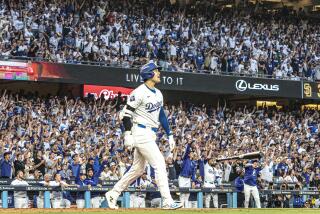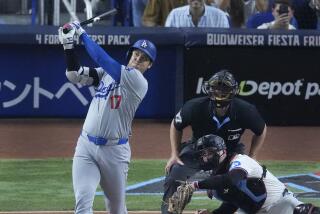It Wasn’t an Easy Decision for Horner
MIAMI — Three days before, when rain had chased everybody else under cover, he was a solitary figure on a soaked practice field.
The workout had been interrupted and the players who hadn’t made the trip to West Palm Beach were in the dugout when there was a sudden burst of laughter. “Stay alive down there,” Oriole pitcher Dave Schmidt shouted after the hitter dropped to the ground to avoid an errant baseball.
“Get a good pitch,” Schmidt yelled when the hitter again had to duck to avoid being hit. Six pitches went by before the hitter got to swing his bat.
Even the elements were working against Bob Horner, who already had an inkling of the inevitable. The rain seemed to have ungreased the pitching machine, but as long as it was still flinging balls in his general direction, Horner was swinging.
Not until the machine emptied itself did Horner pack his gear and trudge slowly toward the dugout. His antics in the batting cage had provided a brief, comical interlude to spring training, but the humor was lost on Horner, who was unaware of his captive audience. As he entered the dugout, Horner’s face gave an indication of what was to come.
Though nobody suspected, Horner was getting the message that his shoulder wouldn’t survive spring training. He mulled his decision for two days before calling Orioles General Manager Roland Hemond.
In effect, what the veteran slugger said was: “I can’t do it anymore.”
Thursday, without completely drawing up the bridge, Horner made it official. He called off his comeback attempt with the Orioles and headed for his home in Dallas.
He probably felt out of place at a news conference hastily arranged by the Orioles. He had spent all but two years of his career with the Atlanta Braves, having played in Japan in 1987 and briefly with the St. Louis Cardinals last year.
The Orioles were the only team that invited him to camp so he could try to prove himself. Considering the club’s need for a right-handed hitter, Horner might have been able to milk the situation.
“It’s a credit to him and the kind of person he is that he decided to come to us now rather than later in the spring, or early in the season,” Hemond said.
“It wouldn’t be fair to the Orioles, or to (Manager) Frank Robinson for me to wait,” Horner said. “They have a lot of hard decisions to make before they head north. And my shoulder is not near where it needs to be.”
Horner had been afforded the luxury of setting his own timetable before facing live pitching. Thursday he was scheduled to go to West Palm Beach and be in the lineup against his former team.
“I was looking for him,” said Braves outfielder Dale Murphy. “I was saying, ‘Where is he? Where is he?’ I was going to get on him for not making the trip Monday, because I never make (spring training) road trips, either.”
When Murphy found out why Horner wasn’t there, it hit him hard. “I was kind of shocked,” he said. “Like everyone else, I didn’t know what kind of shape his shoulder was in. I saw him rehabilitating it in St. Louis last year, and I figured everything would be OK.”
But the surgery last August was the third performed on Horner’s left shoulder. You only get three strikes at the plate, and he figures there’s no need to get any more in the operating room.
“I don’t see what good another operation would do,” Horner said. “I still have a family I want to raise, and I don’t think it would be good for them to have a cripple for a father. It reached the point where I couldn’t focus on making the club--I was too worried about the shoulder.
“I’m not going to slam the door completely,” he said, “but right now I have no thoughts other than to go home to my family and let the shoulder heal--if it’s going to heal.”
Horner said he knew he wasn’t 100% when he accepted the Orioles’ invitation to spring training. “When I left Dallas I told everybody that I had no pain, but it (the shoulder) was still bothering me. I didn’t know if it was just stiffness, because I hadn’t played or what.
“I couldn’t just shut it down then, because then you question yourself the rest of your life. I had to come here and find out for sure. I really felt I could still play. The key was the shoulder - if it was OK, I’m OK.
“Frank kept saying, ‘You’re rusty,’ and you keep thinking that one more day . . . one more week . . . but finally you have to say you’re just kidding yourself. Eventually, it would have caught up to me, and I didn’t want to lead the Orioles on when I knew I couldn’t do it. Stepping down is the toughest decision any player has to make. You can put it off, but eventually you wake up and realize enough is enough.”
During Horner’s injury-plagued 10-year career, perhaps nobody appreciated him more than Murphy, whose best years came while hitting in front of his longtime friend.
“He was one of those hitters who was just unusual,” Murphy said. “He would come to spring training and his swing would be there. He wouldn’t need any time. He had the swing - short and quick, and he had a good eye. Had it not been for injuries he would really have put some big numbers on the board. As far as I’m concerned he’ll always be one of the best power hitters. I feel bad for him.”
Horner, although acknowledging that injuries have made his career “weird,” refused to feel sorry for himself. “All you can do is play the hand that’s dealt you,” he said.
Horner stepped off the campus of Arizona State, where he originally hurt his shoulder and underwent surgery for the first time, and into the Braves’ lineup in 1978. He would never spend a day in the minor leagues. By the age of 29, and despite wrist and shoulder injuries that plagued him throughout his career, he had reached 200 homers. Neither Ted Williams nor Mike Schmidt had hit that many at the same age.
Now, at the age of 31, his career has evidently come to an end--in the batting cage along the right-field line in Miami’s Bobby Maduro Stadium.
The pitching machine and his left shoulder came up empty at just about the same time.
More to Read
Go beyond the scoreboard
Get the latest on L.A.'s teams in the daily Sports Report newsletter.
You may occasionally receive promotional content from the Los Angeles Times.










